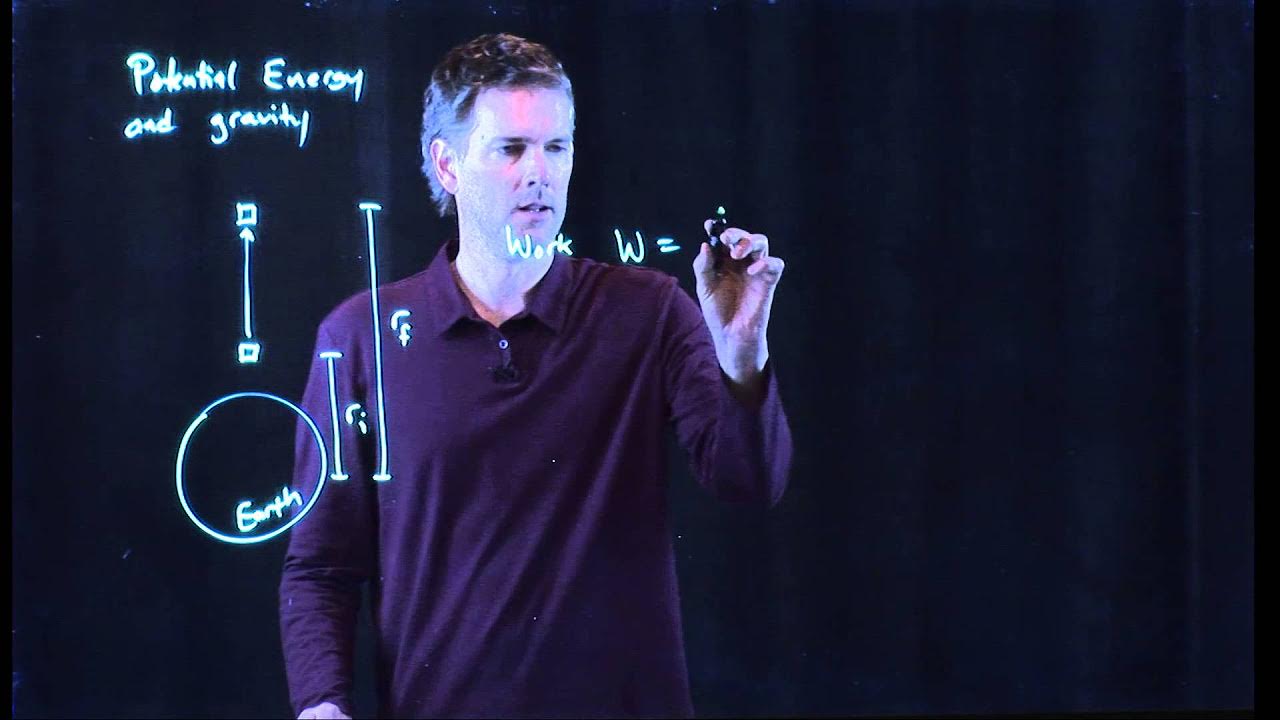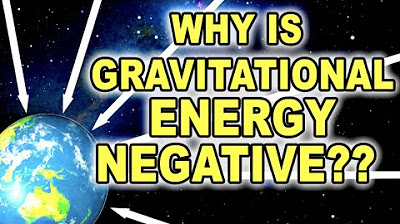Deriving The Formula For Gravitational Potential Energy
TLDRThe video script delves into the derivation of the gravitational potential energy (GPE) formula, emphasizing its generality over the basic mgh equation. It introduces GPE as the work done by an external force to bring two bodies from infinite separation to their current position, highlighting the necessity of calculus for a rigorous proof. The script explains that the integral of gravitational force with respect to distance represents work, leading to the formula -GMm/r for GPE. The explanation is clear, mathematically straightforward, and invites viewers to explore further applications in physics, such as orbital mechanics and escape velocity.
Takeaways
- 📚 The video discusses the derivation of the more general formula for gravitational potential energy (GPE), beyond the basic mgh formula.
- 🔄 The GPE is defined as the work done by an external force to bring two bodies from infinite separation to their current position.
- 🤔 The concept of GPE involves both bodies, and referring to the GPE of a single body is not technically correct.
- 🚀 The process of bringing objects together from infinity is imagined to occur at a very low velocity to minimize kinetic energy.
- 📈 The GPE is found by integrating the force of gravity with respect to distance, which is a curve due to the inverse square law.
- 🌐 The force of gravity is dependent on the distance 'r', following the equation GMm/r^2, where G is the gravitational constant, M and m are the masses, and r is the distance.
- 🧮 The integral of the gravitational force equation from infinity to r gives us the work done, and consequently, the GPE.
- 🌟 The integral calculation results in -GMm/r, which represents the work done at a finite distance r and tends to zero as r approaches infinity.
- 💡 The derived formula for GPE, -GMm/r, is a fundamental concept in physics and has applications in orbital mechanics and escape velocity calculations.
- 🎓 The video emphasizes the importance of understanding calculus to rigorously derive and comprehend the GPE expression.
- 👋 The video concludes by encouraging viewers to explore more derivations and applications of GPE in related physics topics.
Q & A
What is the main topic of the video?
-The main topic of the video is deriving a more general formula for gravitational potential energy (GPE) using calculus, which is applicable at any distance and not just limited to changes in GPE at relatively short heights.
Why is calculus needed to derive the expression for gravitational potential energy?
-Calculus is needed because the force of gravity, which is dependent on the inverse square of the distance 'r', changes as the distance changes. This requires integration, a fundamental concept in calculus, to find the area under the curve of force with respect to distance.
What is the basic definition of gravitational potential energy for two bodies?
-The gravitational potential energy of two bodies is the work done by an external force to bring the bodies from an infinite distance apart to their current position.
Why is it incorrect to talk about the GPE of just one body?
-It is incorrect because the definition of GPE involves the work done to bring two bodies from infinite separation to their current position. Focusing on just one mass does not technically represent the full concept of GPE as defined.
How is the object brought in from 'infinitely far away' in the GPE calculation?
-The object is conceptually brought in from infinitely far away at a very low velocity to ensure that its kinetic energy remains low, which is critical for accurately calculating the change in potential energy.
What is the formula for gravitational force that is integrated with respect to distance?
-The formula for gravitational force that is integrated is GMm/r^2, where G is the gravitational constant, M and m are the masses of the two bodies, and r is the distance between their centers of mass.
How does the integral of the gravitational force equation relate to work?
-The integral of the gravitational force equation with respect to distance represents the work done by the external force. This is because the integral calculates the area under the curve of force versus distance, which corresponds to the total work done.
What is the result of evaluating the integral for the gravitational force?
-The result of evaluating the integral is -GMm/r, which represents the work done by the external force and is equivalent to the gravitational potential energy of the two bodies at a given distance 'r'.
What happens to the expression for gravitational potential energy when r tends to infinity?
-When r tends to infinity, the expression for gravitational potential energy tends to zero, as the work done by the external force to bring the bodies from infinity to that point would be zero.
What other topics are suggested to explore further in the video?
-The video suggests exploring other derivations in physics, as well as applications of the concept of gravitational potential energy in topics like orbital mechanics and escape velocity.
Outlines
🌌 Deriving the Gravitational Potential Energy Formula
This paragraph introduces the concept of deriving a more general formula for gravitational potential energy (GPE) beyond the basic mgh model. It emphasizes the need for a formula that accounts for GPE at any distance and not just a change in GPE. The video aims to explain the derivation process, assuming the viewer has a basic understanding of integral calculus. The Gravitational Potential Energy is defined as the work done by an external force to bring two bodies from infinite separation to their current position, highlighting that it technically applies to both bodies, not just one. The paragraph also discusses the concept of bringing an object from 'infinitely far away' at a very low velocity to maintain low kinetic energy.
Mindmap
Keywords
💡Gravitational Potential Energy
💡Integral Calculus
💡Work
💡Force
💡Distance
💡External Force
💡Infinite Distance
💡Inverse Square Law
💡Area Under a Curve
💡Derivation
💡Orbital Mechanics
Highlights
Deriving a more general formula for gravitational potential energy.
The basic mgh formula only describes a change in GPE at relatively short heights.
The general formula can be used at any distance and provides a total value.
Understanding the need for calculus in deriving the expression for gravitational potential energy.
Gravitational Potential Energy (GPE) is the work done by an external force to bring two bodies from infinite separation to their current position.
When asked about GPE of one body, it is not technically correct but commonly understood.
The process of bringing objects together must be done at a very low velocity to keep kinetic energy low.
The definition of GPE is central to the mathematical derivation that follows.
Work is defined as force times distance, which is crucial in understanding gravitational force.
Gravity's force changes as distance changes, being dependent on the inverse square of the distance.
The area under the curve of force vs. distance represents the work done.
The gravitational force equation is GMm/r^2, which is integrated with respect to r.
The integral of gravitational force with respect to distance gives us the work done by the external force.
The final equation for the work done is -GMm/r, which is equivalent to the GPE of the bodies.
The video provides a summary of the definition of gravitational potential energy and its derivation using calculus.
The concepts are fundamental for understanding orbital mechanics and escape velocity.
Transcripts
Browse More Related Video

13.3a Gravitational Potential Theory | A2 G-Fields | Cambridge A Level Physics

Work Done By Gravity and Gravitational Potential Energy - Physics

Gravitational Potential Energy Calculations (GPE) - Mass x Gravity x Height OR GPE=mgh

Potential energy and gravity

Gravitational Potential Energy & Work Done + Calculation Example // HSC Physics

What is Gravitational Potential Energy - a deeper understanding
5.0 / 5 (0 votes)
Thanks for rating: